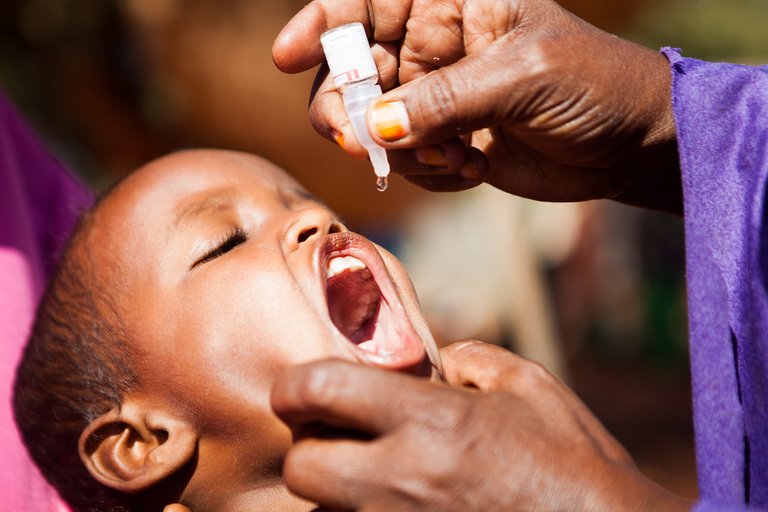The Global Eradication of Polio, the Need for Vaccination.
It is funny how up to date, some people still refuse/reject vaccination, not only do they do it to themselves, but also to their innocent kids, trying to prevent a child from getting vaccinated to me just makes no sense, my sister came up during her service period and she told us about how people who lived in the rural area where she served were rejecting vaccination for their children, the village head had called an urgent meeting stating that he believes that the vaccination was a demonic sign and their children should not be allowed to receive it. My sister tried to speak to a few parents who were close to her, but the village head remained adamant with his decision, if not for her visit to this rural area, we would have never known of the presence of this terrible culture and system of operation.
Let me share a story I read, that instilled in my subconscious, the important need for vaccination. In Cami's case, there was no access to vaccination when she contacted it, she even had access to extreme care and love, but still got affected in a way, now imagine those kids who have the access to vaccination, but still reject it. Cami was seven (7) when she contracted polio back in 1954, no one can explain how that happened as she was an isolated case in her community then. Through the love and support, she got both medically and from family members, she was able to make a long, painful but good recovery.

flickr.com
She had to go through years of physical therapy, lots of surgeries, and an inability to get engaged in physical activities, she now has to live with muscle weakness, wears two leg braces, and has to walk with crutches. Cami's story Sadly, parents would intentionally deny their children getting vaccinated, but let's go on to learn about polio and what surrounds its spread.
Nigeria as a case study.
In 1988, which was exactly 8 years after there has been successful eradication of smallpox, the global polio eradication initiative was published by a private-public partnership that had the goal of eradicating polio by the year 2000, this means they set a two-year plan to have the virus eradicated, the question of whether this goal was attainable, is what we will find out as we move along in this post. At the time the goal was set, the total number of available polio cases was 350 000 and the disease was endemic in 125 countries. The movement had an impressive progressive rate, but they were not able to meet up with the eradication by 2000 as set and they did not bother to set new deadlines either.
In African countries, the deadline was not attainable because, there was an absence of strict surveillance in most of the existing African countries, before there was the introduction of the Group Polio Project (CGPP), the group made it very mandatory to eradicate existing wild poliovirus in Nigeria, as Nigeria was regarded as a source of wild poliovirus exportation in the African region. Local concerns were also overlooked alongside national and international issues to the extent that, there was almost a collapse of the polio eradication initiative that was implemented initially in Nigeria in 1955. After a few years, there was a boycott campaign that was ignited by religious health and fertility concerns, this threatened the vaccination efforts in most existing Northern Nigerian states, there was also an unverified rumor about the safety of the polio vaccine, and as a result of this, it was highly difficult to restore public trust, support, and cooperation.
After the boycott of the polio vaccine happened in Northern Nigeria, the Nigeria government then in collaboration with the CORE GROUP POLIO PROJECT (CGPP), the WORLD HEALTH ORGANIZATION (WHO), and the UNITED NATIONS CHILDREN'S FUND (UNICEF), revamped the eradication initiative of polio in 2006, they did so by addressing the health and safety concerns of northern communities and employed strategic staff whose mission was to build community engagement, target the areas that are at risk, track the children whose vaccination may have been missed and ensuring a community-based surveillance and independent monitoring campaign.
With the help of adequate strategies and proper vaccination, cases of the polio virus have decreased by 99% since 1998 from 350,000 reported cases in 125 countries to only 6 cases in 2021. Out of the three strains of wild polio virus, (Type 1,2, and 3), type 2 was eradicated in 1999, type 3 was eradicated in 2020, and in 2022, wild poliovirus remained in only two countries; Pakistan and Afghanistan.
However, This article, shows that polio is emerging in some countries that have remained free of polio for several decades, this is a great reminder that until all forms of polio have completely disappeared from the earth, children are still at stake. A good example is the detection of the vaccine-derived polio case in New York in 2022, this has raised an alarm for another spread of immunization.
This is why vaccination is necessary, no child should be left unvaccinated, and parents should help make the vaccination process easier rather than rejecting/refusing it.
References.
https://www.paho.org/en/stories/history-polio-eradication-re-emergence
https://www.unicef.org/immunization/polio
https://www.sciencedirect.com/science/article/pii/S2666535221000690
https://www.ncbi.nlm.nih.gov/pmc/articles/PMC6730569/
https://www.thelancet.com/journals/lancet/article/PIIS0140-6736(22)01875-X/fulltext
https://www.who.int/health-topics/poliomyelitis#tab=tab_1
https://www.gatesfoundation.org/our-work/programs/global-development/polio
https://www.un.org/africarenewal/news/polio-no-longer-endemic-nigeria-%E2%80%93-un-health-agency
Thanks for your contribution to the STEMsocial community. Feel free to join us on discord to get to know the rest of us!
Please consider delegating to the @stemsocial account (85% of the curation rewards are returned).
Thanks for including @stemsocial as a beneficiary, which gives you stronger support.